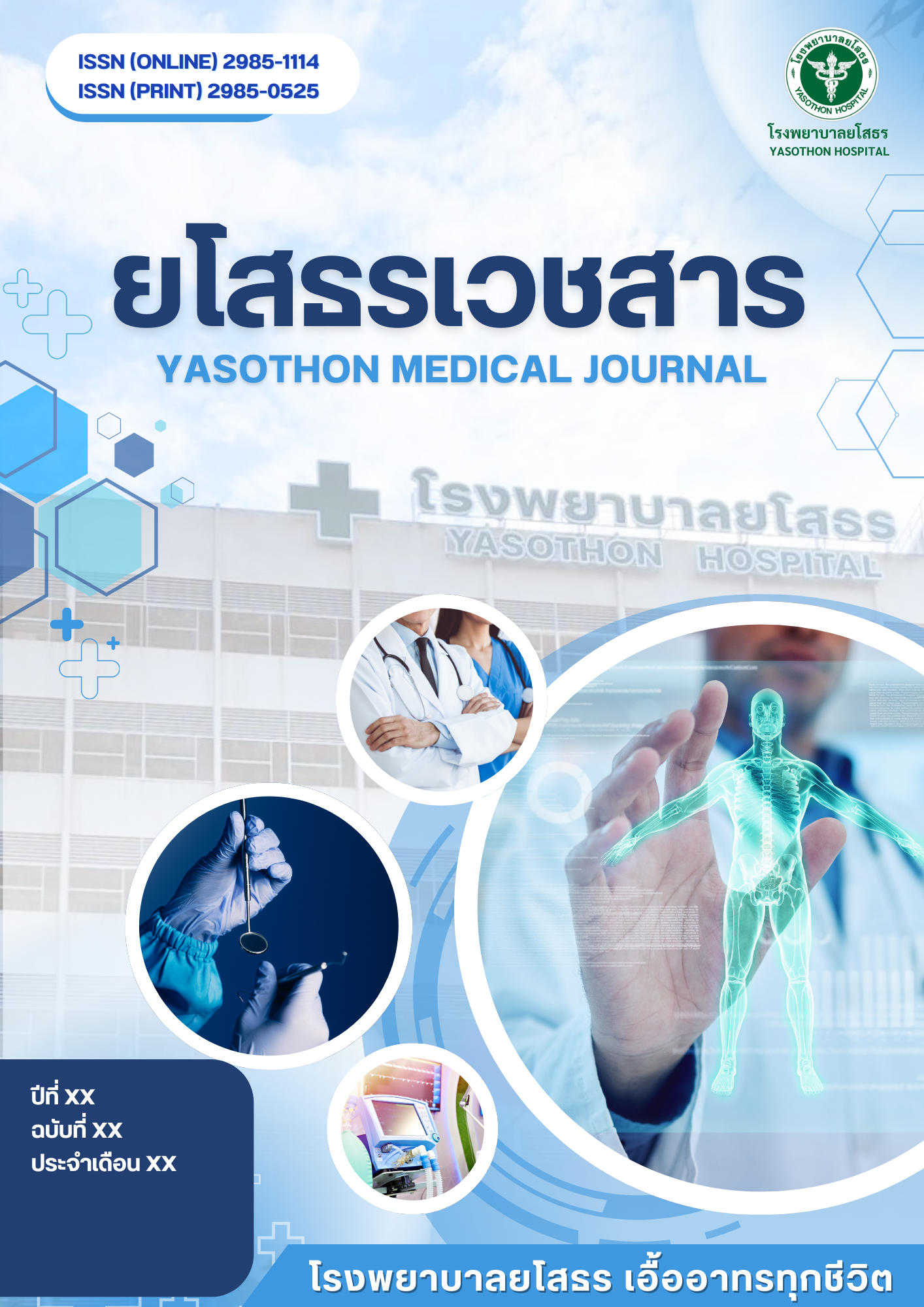The Development of the Care Model for Children with Pneumonia in Yasothon Hospital
Keywords:
The Care Model, PneumoniaAbstract
Background: This research aims to develop and study the results of developing a care model for children with pneumonia at Yasothon Hospital.
Objective: This study was conducted between 6 January 2022 and 31 October 2022, and was conducted in 4 phases: Phase 1: situation study; Phase 2: model development; Phase 3: trial use; and Phase 4: evaluation. The sample was selected based on the inclusion criteria: (1) 56 pediatric pneumonia patients and 56 caregivers, and (2) 10 professional nurses. The research instruments were: (1) Nursing practice guidelines for pediatric pneumonia patients and assessment of warning signs of a crisis (PEWS), (2) Nursing capacity development program, validity checked by 5 experts. The instruments used for data collection were: (1) Indicator recording form, (2) Personnel satisfaction questionnaire, reliability tested, Cronbach's alpha coefficient of the entire version was 0.81, (3) Personnel knowledge measurement form, total difficulty value was 0.77, (4) Patient satisfaction questionnaire, reliability tested, Cronbach's alpha coefficient of the entire version was 0.98, data were analyzed using descriptive statistics, and differences were compared using Paired t-test.
Results: The study found that 1) The nursing model for pediatric pneumonia patients consisted of (1) a care plan for pediatric pneumonia patients, (2) a program to promote knowledge about pneumonia for caregivers, and (3) screening using a symptom change warning system (PEWS). 4) Discharge planning program using a 5-step discharge planning model consisting of (4.1) assessment of problems and post-discharge care needs, (4.2) diagnosis of problems following post-discharge care, (4.3) determination of discharge plan according to D-Method, (4.4) compliance with the discharge plan, and (4.5) evaluation.
2) The results of the model include service provider results, with overall staff satisfaction being at a very high level ( = 4.73, S.D. = 0.15), and the compliance with the care guidelines was at 91.07 percent. The results of the service users were as follows: The number of unplanned ICU transfers, respiratory failure, and readmissions within 28 days was significantly reduced at the .05 level, and overall caregiver satisfaction was very high ( = 4.84, S.D. = 0.14). Caregivers' knowledge after the development was higher than before the development. ( before = 8.83, after = 16.38) significantly at the .05 level.
Conclusion: The development of a care model for children with pneumonia produces good results and should be the development guidelines applied to other groups of patients with chronic diseases.
References
Cantais A, Mory O, Pillet S, Verhoeven PO, Bonneau J, Patural H, et al. Epidemiology and microbiological investigations of community-acquired pneumonia in children admitted at the emergency department of a university hospital. J Clin Virol 2014; 60(4): 402-7. doi: 10.1016/j.jcv.2014.05.006. PubMed PMID: 24915939.
Le Roux DM. Childhood deaths due to pneumonia: a novel causal analysis of aetiology. Lancet Child Adolesc Health 2024; 8(3): 178-9. doi: 10.1016/S2352-4642(24)00015-4. PubMed PMID: 38281496.
World Health Organization. Pneumonia in children [Internet]. 2022 [Cited 2024 Apr 11]. Available from: https://www.who.int/news-room/fact-sheets/detail/pneumonia
United Nations Children’s Fund (UNICEF). Pneumonia [Internet]. 2024 [Cited 2024 Apr 11]. Available from: https://data.unicef.org/topic/child-health/pneumonia
สมาคมโรคระบบหายใจและเวชบำบัดวิกฤติในเด็ก ราชวิทยาลัยกุมารแพทย์แห่งประเทศไทย. แนวทางการดูแลรักษา โรคติดเชื้อเฉียบพลันระบบหายใจในเด็ก พ.ศ. 2562. กรุงเทพฯ: บียอนด์ เอ็นเทอร์ไพรซ์; 2562.
งานเวชระเบียน. สถิติผู้ป่วยตั้งแต่แรกเกิดจนถึงอายุ 15 ปี ที่เข้ารับการรักษาในปี พ.ศ. 2563–2565. ยโสธร: โรงพยาบาลยโสธร; 2565
Donabedian A. The quality of care: How can it be assessed? JAMA 1988; 260(12): 1743-8. doi: 10.1001/jama.260.12.1743. PubMed PMID: 3045356.
Schepp KG. Psychometric assessment of the preferred participation scale for parent of hospitalized children [Unpublished manuscript]. University of Washington, School of Nursing, Seattle: WA; 1995.
ฆนรส อภิญญาลังกร, วราภรณ์ ผาทอง, รัตนาภรณ์ ภุมรินทร์. ประสิทธิผลการใช้แนวปฏิบัติทางคลินิกสำหรับการจัดการทางเดินหายใจในผู้ป่วยเด็กโรคปอดอักเสบ. วารสารวิทยาลัยพยาบาลพระปกเกล้า จันทบุรี ธันวาคม 2559; 27(เพิ่มเติม 1): 139–51.
ศิริวันต์ ยิ้มเลี้ยง, พรทิพย์ รัตนวิชัย, ช้องมาศ จักรวิเชียร. การพัฒนารูปแบบการดูแลผู้ป่วยเด็กโรคหอบหืดโดยการมีส่วนร่วมของทีมสหสาขาวิชาชีพ โรงพยาบาลพิจิตร. วารสารกองการพยาบาล 2552; 36(3): 96-112.
จารุพรรณ ตันอารีย์. ประสิทธิภาพของการใช้ Pediatric Early Warning Score: PEWS ในหอผู้ป่วยกุมารเวชกรรม โรงพยาบาลกำแพงเพชร. วารสารกุมารเวชศาสตร์ 2559; 55(3): 196-200.
อัจจิมาวดี พงศ์ดารา. ผลการใช้ High Flow Nasal Cannula (HFNC) ในผู้ป่วยเด็กที่มีกาวะหายใจลำบาก. วารสารกุมารเวชศาสตร์ 2562; 58(3): 175-80.
ดวงเนตร์ ภูวัฒนาวนิชย์. ผลของระบบการพยาบาลแบบสนับสนุนและให้ความรู้ต่อความรู้และความสามารถของมารดาในการดูแลผู้ป่วยเด็กโรคปอดอักเสบที่เข้ารับการรักษาในโรงพยาบาล. วชิรสารการพยาบาล กรกฎาคม-ธันวาคม 2560; 19(2): 35-44.
รัชนีย์ พิมพ์ใจชน. ผลของการใช้รูปแบบเฝ้าระวังอาการเปลี่ยนแปลงและสัญญาณเตือนของผู้ป่วยต่อการย้ายเข้าหอผู้ป่วยวิกฤตโดยไม่ได้วางแผน. ชลบุรี: กลุ่มงานการพยาบาลผู้ป่วยศัลยกรรม โรงพยาบาลศูนย์ชลบุรี [อินเตอร์เน็ต]. 2557 [เข้าถึงเมื่อ 27 เมษายน 2565]. เข้าถึงได้จาก: http://www.cbh.moph.go.th/app/intranet/files/km/1507186947_8.
Downloads
Published
Versions
- 2025-05-23 (2)
- 2025-05-01 (1)
How to Cite
Issue
Section
License
Copyright (c) 2025 Yasothon Medical Journal

This work is licensed under a Creative Commons Attribution-NonCommercial-NoDerivatives 4.0 International License.
บทความที่ได้รับการตีพิมพ์เป็นลิขสิทธิ์ของยโสธรเวชสาร







